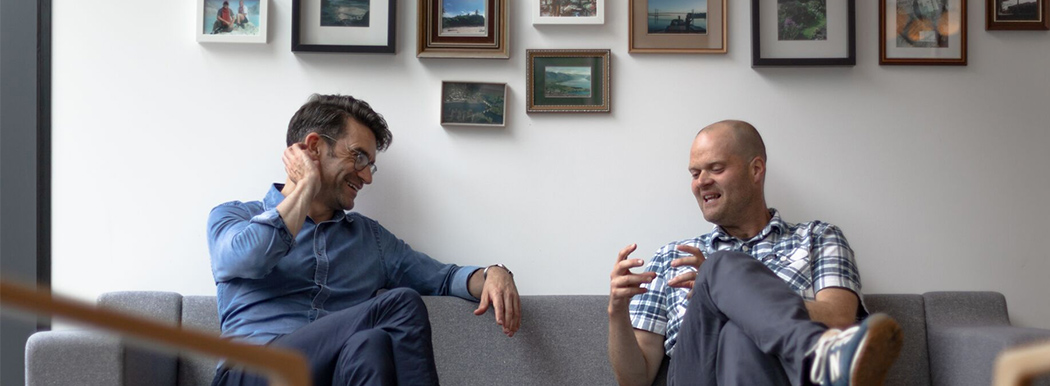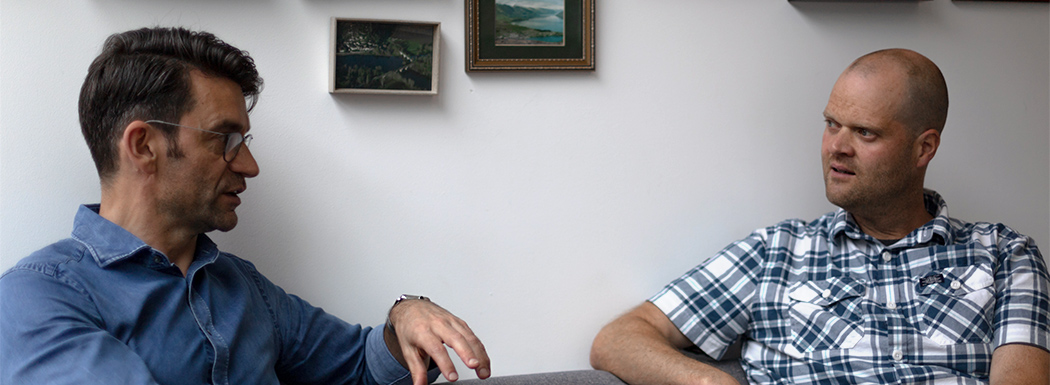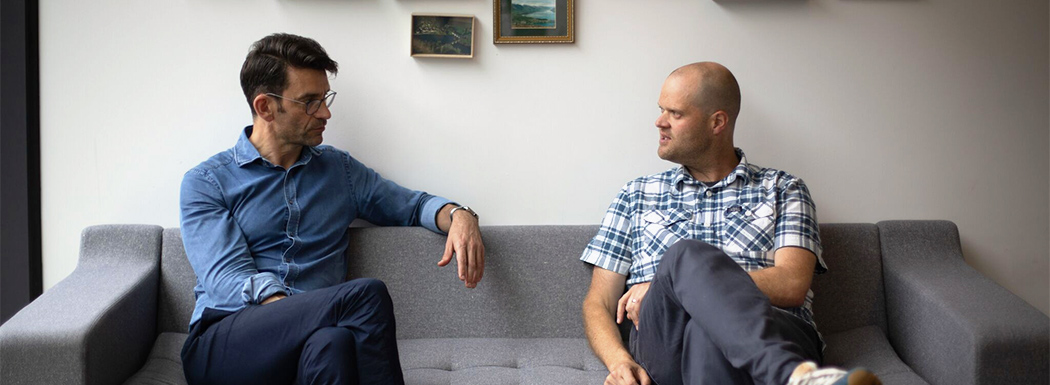
Our story
cxpartners was founded in 2004 by Giles Colborne and Richard Caddick. In 2020 cxpartners became part of Sopra Steria. Here they talk about their beliefs: why putting people first gets business results; the need for collaboration in solving complex problems; and why strategy needs to be grounded in the ability to deliver.
Why did you form cxpartners?
Richard: We’d worked together at a global digital agency network for several years and we wanted to create a different kind of consultancy. We wanted to put people back at the centre of design, technology, and business.
Giles: This was back in 2004. We’d been doing work we were really proud of - we’d shown how user-centred design could deliver business results and improve customer satisfaction. But we were a bit of an oddity, an island - we weren’t following the traditional agency model.
Traditional agencies believe that they need to sell ‘creative genius’ or ‘business strategy.’
The people we worked with just assumed they knew what customers wanted and skipped past that bit. It seemed wrong. It made us uncomfortable.
Richard: We were going to companies like Centrica and Peugeot and saying ‘people don’t use savings accounts the way you think.’ or ‘people don’t buy cars the way you think.’
We could prove our work helped companies get business value out of digital services. So we’ve always been about ‘people first in a digital world.’ It’s just that elsewhere there was a lot of ‘strategy first’ or ‘creative first’ going on.
Were you on a mission?
Richard: We still are. We want everyone to be customer-centric. From the start, it was about sharing our knowledge. Speaking at conferences. Showing our clients how to do what we do.
Giles: We’ve both written books, and we’ve given staff time and encouragement to write their own. Richard’s book was a set of templates and methods - all the latest stuff we were using at the time. Mine is about Simplicity which is the thing I’ve been trying to create in design and in business throughout my career.
Richard: Helping our clients to evolve their practice is important.
Giles: Some people think design is the way it looks, and a lot of people say ‘design is the way it works.’ But the thing is, how it works just reflects the way a company works and thinks.
If you’re a company that is more concerned with efficiency than what the customer wants, then that’s going to come across in the design.
Even if you change the design, without changing the company, over time there’ll be lots of little maintenance updates and the design will just go back to the way it was.
Richard: We want to help companies to change - to become more user centred - otherwise they’re not going to be able to live with designs that put the customer first. They’ll make random changes or they’ll make convenient changes.
Giles: And they’re not going to get the business results. We believe businesses, organisations, need to start by putting their customers or users first because it works every time we do it. When people try it the other way, to put policy or technology, or a clever strategy first, then it usually fails or else limps along a bit.
Richard: It’s just a nicer way for people to work, too – for our clients. We’re fortunate that our clients care about doing the right thing for their customers. They all have ‘the customer’ somewhere in their objectives: a sales target, or a net promoter score, or ‘becoming a market leader’ but those things feel a bit random.
When you’re meeting customers, understanding them, helping them, then your work becomes more meaningful. You stop trying to hit a sales target and you start trying to help customers buy the right thing, and boom your sales go up.
Giles: I know everyone says ‘we’re collaborative’ but for us, taking a collaborative approach affects the way we do everything. We spend a lot of time listening. We constantly ask ‘what can we do better?’ We designed our offices so that clients could come and work alongside us. We don’t hide the design process.

So were you strategists or makers?
Giles: Both!
Richard: We’ve both got practical skills. I’m a designer and we’ve both hand-coded websites or written software.
Giles: Hacking at WordPress!
Richard: If you’re trying to come up with a strategy and you understand the effort it takes to make stuff, then you understand how important it is to build the right thing and the link between strategy and execution.
Giles: Yes. You have to understand all the parts - the technology, the people, and the business. I’ve been on the receiving end of expensive reports from big strategy firms. They tend to come up with vague or dumb ideas that fill a gap on a strategy chart. That’s not the same as designing a practical service that works for customers. They think it is, but only because they’ve never built stuff.
Richard: We want mixed [interdisciplinary] teams that know how to ask questions when someone says something’s impossible or easy. You need mixed teams so that the right questions get asked early on.
Would you say that leads to radical designs?
Richard: Sadly, we live in a world where radical design is interpreted as the superficial - the shiny creative. Design should be about how stuff works for people first and foremost.
Giles: Innovation isn’t about flying cars. The radical thing comes from involving people. What you get is this simplicity and elegance.
All those formulas that people have for radical ideas, like brainstorming cards or ‘zigging when everyone else is zagging’ they just seem so contrived. Simplicity and clarity are better. Those things are always radical because they’re so rare.
Richard: Making change happen is radical. Delivering improvements is radical. Giving people services and products that work is radical.

Do you end up challenging the client’s ideas?
Richard: Our clients appreciate the ways we challenge them - we ground it in evidence and we listen to their goals and constraints. So long as everyone on the team recognises they share the same goals, it’s easy, to be honest, and open. We deliver better work as a result.
Giles: So many consultants just spend their time trying to look good in front of their clients – not offending them, trying to ‘manage the message.’ Important stuff gets left unsaid, rather than working with them to come up with a solution that works.
Richard: Plus working with them, it’s so much easier when you take a risk and say something hard like ‘there’s a problem with your business model.’ Bad ideas get dropped faster, new ones come along instead. Everything just tck, tck, tck fits together.
Aren’t you afraid that your clients will just learn to do it on their own?
Giles: We want them to! It’s important. I said we need them to change. They’re big companies. If we can get more of them to be able to do this, then more good stuff will happen.
Richard: We ask our clients: do you think there’s a place in the world for a company like cxpartners. They always say: yes. There’s always more they can do to get better, and more that we’re learning that we can share with them.
Giles: When we started it would just be about showing project managers how to run a quick user test. Now we’re helping boards to measure how customer-centric their entire company is.
Richard: And we’re being asked to measure those kinds of change, too. We believe in the importance of measuring outcomes. Again, I think that goes back to our early experience working in the Dot Com Boom. While the people around us were building stuff because the client asked them to, we were always trying to measure outcomes.
Giles: For one thing asking ‘well, how will we measure that?’ made projects better because we’d come away with a brief like ‘improve productivity’ rather than ‘merge these intranets.’ But it also gave our clients great case studies to share with their bosses.
Richard: It’s a scary thing though. It’s easy for everyone to say ‘we want a measurable outcome’ but when the time comes to take the readings, often people aren’t so sure! We tell that to them - wanting to get it right for their customers will keep us both up at night.
Giles: But the process works. We know if we’ve listened to customers, involved the people in the client’s business, and kept ourselves honest, that we’ll get the result. It looks like magic, but I think it’s just about staying true to your principles.
